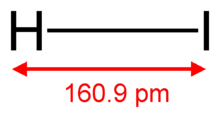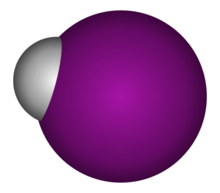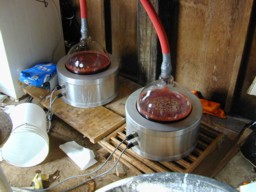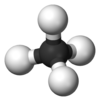يوديد الهيدروجين

| |

| |
| الأسماء | |
|---|---|
| اسم أيوپاك
Hydrogen iodide
| |
| أسماء أخرى
Hydriodic acid, Hydroiodic acid
| |
| المُعرِّفات | |
| رقم CAS | |
| ECHA InfoCard | 100.030.087 |
PubChem CID
|
|
| رقم RTECS |
|
CompTox Dashboard (EPA)
|
|
| الخصائص | |
| الصيغة الجزيئية | HI |
| كتلة مولية | 127.904 g/mol |
| المظهر | Colorless gas |
| الكثافة | 2.85 g/mL (-47 °C) |
| نقطة الانصهار | |
| نقطة الغليان | |
| الحموضة (pKa) | –10 |
| معامل الانكسار (nD) | 1.466 |
| البنية | |
| الشكل الجزيئي | Terminus |
| Dipole moment | 0.38 D |
| الكيمياء الحرارية | |
| الإنتالپية المعيارية للتشكل ΔfH |
0.2072 kJ/g |
| سعة الحرارة النوعية، C | 0.2283 J/(g·K) |
| المخاطر | |
| خطر رئيسي | سام، أكـّال. |
| توصيف المخاطر | R20, R21, R22, R35 |
| تحذيرات وقائية | S7, S9, S26, S45 |
| NFPA 704 (معيـَّن النار) | |
| نقطة الوميض | غير قابل للاشتعال. |
| مركبات ذات صلة | |
أنيونات أخرى
|
|
ما لم يُذكر غير ذلك، البيانات المعطاة للمواد في حالاتهم العيارية (عند 25 °س [77 °ف]، 100 kPa). | |
| مراجع الجدول | |
يوديد الهيدروجين Hydrogen iodide غاز ثقيل عديم اللون ذو رائحة نفّاذة، وصيغته الكيميائية هي HI. ويقوم الكيميائيون بتحضيره عن طريق مزج الهيدروجين مع اليود عند درجة حرارة تتراوح بين 200° و300°م أو عن طريق إضافة الماء إلى خليط اليود والفوسفور الأحمر. Hydrogen iodide and hydroiodic acid are, however, different in that the former is a gas under standard conditions, whereas the other is an aqueous solution of the gas. They are interconvertible. HI is used in organic and inorganic synthesis as one of the primary sources of iodine and as a reducing agent.
. . . . . . . . . . . . . . . . . . . . . . . . . . . . . . . . . . . . . . . . . . . . . . . . . . . . . . . . . . . . . . . . . . . . . . . . . . . . . . . . . . . . . . . . . . . . . . . . . . . . . . . . . . . . . . . . . . . . . . . . . . . . . . . . . . . . . . . . . . . . . . . . . . . . . . . . . . . . . . . . . . . . . . . .
خصائص يوديد الهيدروجين
HI is a colorless gas that reacts with oxygen to give water and iodine. With moist air, HI gives a mist (or fumes) of hydroiodic acid. It is exceptionally soluble in water, giving hydroiodic acid. One liter of water will dissolve 425 liters of HI gas, the most concentrated solution having only four water molecules per molecule of HI.[2]
حمض الهيدرويوديك
يذوب يوديد الهيدروجين بسهولة في الماء، ليكوِّن حمض الهيدرويوديك، ويُسمّى أيضًا حمض الهيدرويوديك وهو حمض قوي فعال للغاية. ويستخدم الكيميائيون حمض الهيدرويوديك في التجارب المعملية ويكون بمثابة عامل اختزال قوي. وتعطي مثل هذه المادة بعضاً من إلكتروناتها إلى مواد أخرى أثناء التفاعل الكيميائي. ويعد هذا الحمض باهظ الثمن إذا استُخدم في الصناعة على نطاق واسع.
- HI(g) + H2O(l) → H3O(aq)+ + I–(aq) Ka ≈ 1010
- HBr(g) + H2O(l) → H3O(aq)+ + Br–(aq) Ka ≈ 109
- HCl(g) + H2O(l) → H3O(aq)+ + Cl–(aq) Ka ≈ 108
التخليق
The industrial preparation of HI involves the reaction of I2 with hydrazine, which also yields nitrogen gas:[3]
- 2 I
2 + N
2H
4 → 4 HI + N
2
When performed in water, the HI must be distilled.
HI can also be distilled from a solution of NaI or other alkali iodide in concentrated phosphoric acid (note that concentrated sulfuric acid will not work for acidifying iodides, as it will oxidize the iodide to elemental iodine).
Another way HI may be prepared is by bubbling hydrogen sulfide steam through an aqueous solution of iodine, forming hydroiodic acid (which is distilled) and elemental sulfur (this is filtered):[4]
- H
2S + I
2 → 2 HI + S
Additionally, HI can be prepared by simply combining H2 and I2: This is a reversible reaction (using conditions 250°C)
- H
2 + I
2 → 2 HI
This method is usually employed to generate high-purity samples.
For many years, this reaction was considered to involve a simple bimolecular reaction between molecules of H2 and I2. However, when a mixture of the gases is irradiated with the wavelength of light equal to the dissociation energy of I2, about 578 nm, the rate increases significantly. This supports a mechanism whereby I2 first dissociates into 2 iodine atoms, which each attach themselves to a side of an H2 molecule and break the H−H bond:[5]
- H
2 + I
2 + (
578 nm radiation) → H
2 + 2I → I···H···H···I → 2HI
In the laboratory, another method involves hydrolysis of PI3, the iodine analog of PBr3. In this method, I2 reacts with phosphorus to create phosphorus triiodide, which then reacts with water to form HI and phosphorous acid:
- 3 I
2 + 2 P + 6 H
2O → 2 PI
3 + 6 H
2O → 6 HI + 2 H
3PO
3
التفاعلات المفتاحية والتطبيقات
Solutions of hydrogen iodide are easily oxidized by air:
- 4 HI + O
2 → 2 H
2O + 2 I
2 - HI + I
2 ⇌ HI
3[6]
HI
3 is dark brown in color, which makes aged solutions of HI often appear dark brown.
Like HBr and HCl, HI adds to alkenes:[7]
- HI + H
2C=CH
2 → H
3CCH
2I
HI is also used in organic chemistry to convert primary alcohols into alkyl iodides.[8] This reaction is an SN2 substitution, in which the iodide ion replaces the "activated" hydroxyl group (water):
HI is preferred over other hydrogen halides because the iodide ion is a much better nucleophile than bromide or chloride, so the reaction can take place at a reasonable rate without much heating. This reaction also occurs for secondary and tertiary alcohols, but substitution occurs via the SN1 pathway.
HI (or HBr) can also be used to cleave ethers into alkyl iodides and alcohols, in a reaction similar to the substitution of alcohols. This type of cleavage is significant because it can be used to convert a chemically stable[8] and inert ether into more reactive species. In this example diethyl ether is split into ethanol and iodoethane:
The reaction is regioselective, as iodide tends to attack the less sterically hindered ether carbon. If an excess of HI is used, the alcohol formed in this reaction will be converted to a 2nd equivalent of alkyl iodide, as in the conversion of primary alcohols into alkyl iodides.
HI is subject to the same Markovnikov and anti-Markovnikov guidelines as HCl and HBr.
Although harsh by modern standards, HI was commonly employed as a reducing agent early on in the history of organic chemistry. Chemists in the 19th century attempted to prepare cyclohexane by HI reduction of benzene at high temperatures, but instead isolated the rearranged product, methylcyclopentane (see the article on cyclohexane). As first reported by Kiliani,[9] hydroiodic acid reduction of sugars and other polyols results in the reductive cleavage of several or even all hydroxy groups, although often with poor yield and/or reproducibility.[10] In the case of benzyl alcohols and alcohols with α-carbonyl groups, reduction by HI can provide synthetically useful yields of the corresponding hydrocarbon product (ROH + 2HI → RH + H
2O + I
2).[7] This process can be made catalytic in HI using red phosphorus to reduce the formed I2.[11]
الاستخدام غير القانوني لحمض الهيدرويوديك
الاستخدام في صناعة الملح
يمكن استخدام حمض الهيدرويوديك لتصنيع يوديد الصوديوم أو يوديد الپوتاسيوم لزيادة محتوى اليود في الملح.
الهامش
- ^ Wiberg, Egon; Wiberg, Nils; Holleman, Arnold Frederick (2001). Inorganic chemistry. Academic Press. pp. 371, 432–433. ISBN 0123526515.
{{cite book}}: CS1 maint: multiple names: authors list (link) - ^ Holleman, A. F.; Wiberg, E. "Inorganic Chemistry" Academic Press: San Diego, 2001. ISBN 0-12-352651-5.
- ^ Greenwood, N. N. and A. Earnshaw. The Chemistry of the Elements. 2nd ed. Oxford: Butterworth-Heineman. p 809–815. 1997.
- ^ Joseph Louis Gay-Lussac (1815), "A Memoir on Iodine", Annals of Philosophy 5: 101
- ^ Holleman, A. F. Wiberg, E. Inorganic Chemistry. San Diego: Academic Press. p. 371, 432–433. 2001.
- ^ Magnuson, J.A.; Wolfenden, J.H. (December 1, 1956). "Hydrogen Tri-iodide". Journal of Physical Chemistry. 60 (12): 1665–1666. doi:10.1021/j150546a021. Retrieved May 26, 2022.
- ^ أ ب Breton, G. W., P. J. Kropp, P. J.; Harvey, R. G. "Hydrogen Iodide" in Encyclopedia of Reagents for Organic Synthesis (Ed: L. Paquette) 2004, J. Wiley & Sons, New York. DOI:10.1002/047084289X.
- ^ أ ب Bruice, Paula Yurkanis. Organic Chemistry 4th ed. Prentice Hall: Upper Saddle River, N. J, 2003 p. 438–439, 452.
- ^ Kiliani, Heinrich (1886-01-01). "Ueber die Constitution der Dextrosecarbonsäure". Berichte der Deutschen Chemischen Gesellschaft (in الإنجليزية). 19 (1): 1128–1130. doi:10.1002/cber.188601901251. ISSN 1099-0682.
- ^ Perlin, A. S.; Purves, C. B. (1953-03-01). "Kiliani's Reduction of Glucose and Fructose Cyanohydrins to the Corresponding Heptanoic Acids and Lactones". Canadian Journal of Chemistry. 31 (3): 227–236. doi:10.1139/v53-033. ISSN 0008-4042.
- ^ Dobmeier, Michael; Herrmann, Josef M; Lenoir, Dieter; König, Burkhard (2012-03-02). "Reduction of benzylic alcohols and α-hydroxycarbonyl compounds by hydriodic acid in a biphasic reaction medium". Beilstein Journal of Organic Chemistry (in الإنجليزية). 8 (1): 330–336. doi:10.3762/bjoc.8.36. PMC 3302097. PMID 22423302.
وصلات خارجية
| HI | He | ||||||||||||||||
| LiI | BeI2 | BI3 | CI4 | NI3 | I2O4, I2O5, I4O9 | IF, IF3, IF5, IF7 | Ne | ||||||||||
| NaI | MgI2 | AlI3 | SiI4 | PI3, P2I4 | S | ICl, ICl3 | Ar | ||||||||||
| KI | CaI2 | Sc | TiI4 | VI3 | Cr | MnI2 | Fe | CoI2 | NiI2 | CuI | ZnI2 | Ga2I6 | GeI2, GeI4 | AsI3 | Se | IBr | Kr |
| RbI | SrI2 | Y | ZrI4 | Nb | Mo | Tc | Ru | Rh | Pd | AgI | CdI2 | InI3 | SnI4, SnI2 | SbI3 | TeI4 | I | Xe |
| CsI | BaI2 | Hf | Ta | W | Re | Os | Ir | Pt | AuI | Hg2I2, HgI2 | TlI | PbI2 | Bi | Po | At | Rn | |
| Fr | Ra | Rf | Db | Sg | Bh | Hs | Mt | Ds | Rg | Uub | Uut | Uuq | Uup | Uuh | Uus | Uuo | |
| ↓ | |||||||||||||||||
| La | Ce | Pr | Nd | Pm | SmI2 | Eu | Gd | TbI3 | Dy | Ho | Er | Tm | Yb | Lu | |||
| Ac | ThI4 | Pa | U | Np | Pu | Am | Cm | Bk | Cf | Es | Fm | Md | No | Lr | |||
- CS1: Julian–Gregorian uncertainty
- ECHA InfoCard ID from Wikidata
- Chemical articles with unknown parameter in Chembox
- Articles containing unverified chemical infoboxes
- Short description is different from Wikidata
- مركبات الهيدروجين
- يوديدات
- أحماض
- هاليدات لافلزية
- DEA List I chemicals
- أحماض معدنية
- مركبات اليود
- عوامل مختزلة








